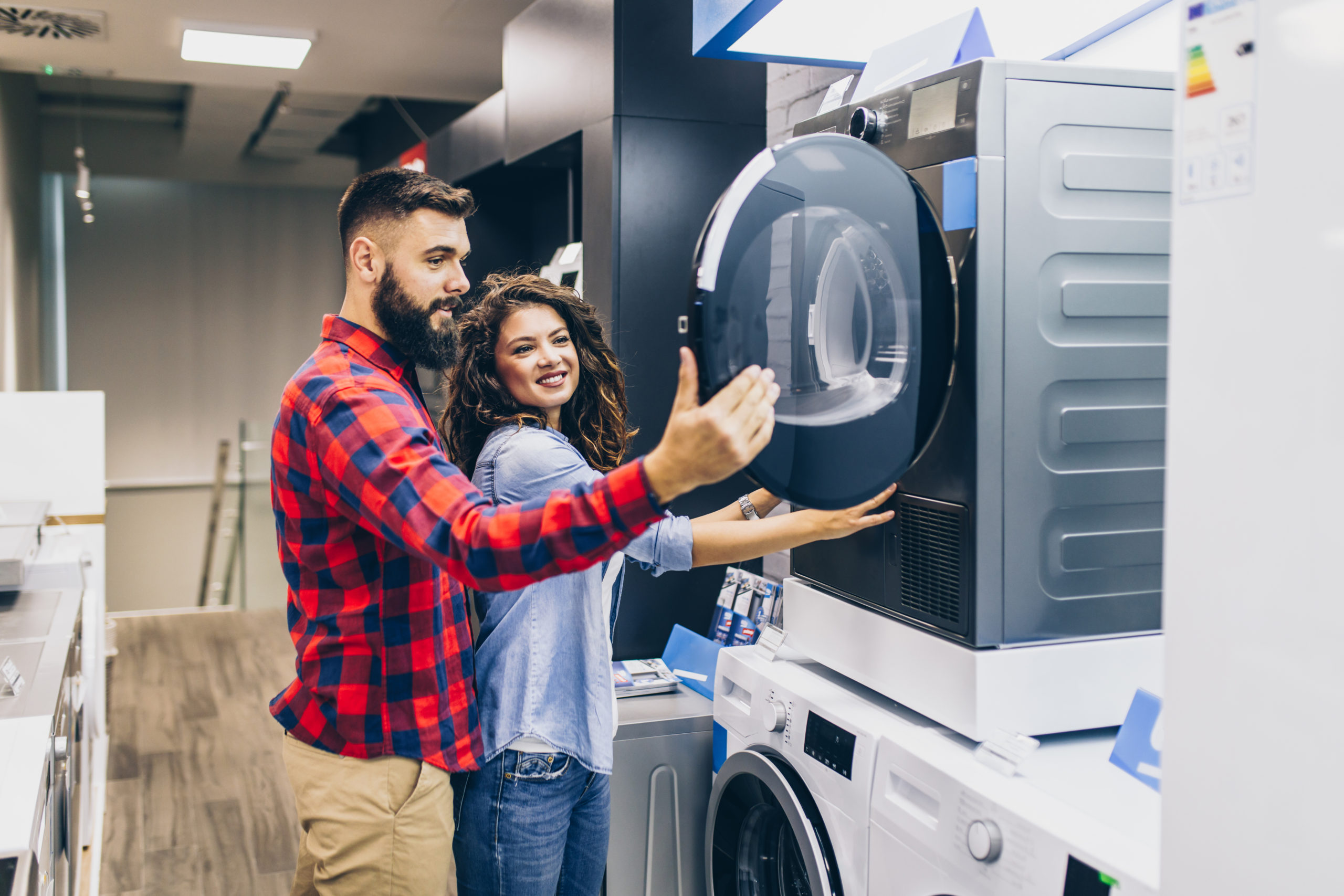
Take a load off with our easy guide to laundry appliances
Washing machine given up the ghost? Dodgy dryer dampening your mood? Whether you’re washing for a family of four or downsizing to an apartment for one, there are laundry appliances to fit your needs.
But if it’s been a while since you last bought one, your head may be spinning with all the new features and options on the market. Take a load off — we’ve done the dirty work for you so that you can go shopping for laundry appliances with confidence.
What is the difference between a front loader, top loader and twin tub?
Top loader machines are more convenient as you don’t have to bend every time you want to load and unload your clothes. Also, top loaders allow you to add clothes in the middle of a cycle, simply by lifting a lid, if you forget a piece or two. A standard top loader with a central agitator is usually a cheaper option upfront.

However, they can still be a bit rougher on your clothes compared with front loaders, which are gentler. Front loaders may be daunting for those who haven’t used them before but the new ones come with lots of added extras and are generally more energy and water efficient — so will have higher star ratings.
And while you may associate twin tubs with your grandparents, a more modern version of this nostalgic appliance is still available. They are also very affordable and the most efficient of all options in terms of water usage. For the many Australians living in water-restricted areas, they also enable you to recycle the water — it won’t drain until you tell it to, so you can use it to rewash or tip the water into your garden. Also, many are manual fill, so you only put in the water you want, and you get the added bonus of exercise going to and from the machine.
What about a washer dryer combo?
Washer dryer combos haven’t always had the best reputation for reliability. But they have improved significantly over the past few years and are good for singles or couples and in homes where space is limited. They are always front loaders and don’t have many of the newer features, including deepwater washing, auto-sensing, deep rinsing, and sanitization cycles, etc. And although they use a similar amount of energy as a condenser dryer, they take twice as long, so choose wisely.
What is a dryer with a condenser?
Dryers with a condenser do not need an external vent, so they can be placed wherever you need them. If there’s no room in your laundry, for example, and you need to put it in the garage. A condenser dryer operates by blowing air over the heating coils into a tumble drum. The hot damp air is then expelled as vapors into a container where it condenses into water. They are very affordable and have quick programs and fast responses.
How can I compare different brands of laundry appliances?
Laundry appliances can range anywhere between $400 and $2500 depending on the brand, capacity, type, and features. Some of the brands with the best reputations in Australia include Bosch, Electrolux, Fisher & Paykel, Haier, LG, Miele, Samsung and Simpson.

Besides the price and size, the characteristics that you should consider before buying any laundry appliances include the type, energy and water usage, noise, capacity, sensors, dual bin, self-cleaning technology, and steam drying, some of which we’ve outlined in more detail below.
How do I compare water and energy consumption in laundry appliances?
If you really want to see the difference in consumption, then you should opt for a laundry appliance that displays both energy and water rating labels. The government-mandated Energy Rating Labelling Scheme ensures all washers and dryers carry labels with stars indicating their efficiency, scaled from one to 10 (most only go up to six). You can use these to compare energy and water consumption of similar capacity machines.
It is important to note the star rating with washing machines relates only to a warm wash, not cold. There have also been significant advances in energy efficiency in dryers – especially with heat-pump technology – which means you can now buy super-efficient dryers with a star rating of 7 to 10.
These energy labels help you reduce energy consumption by:
-
- Giving you clear comparison criteria and helping you choose energy-efficient products.
- Encouraging companies to design ever-more energy-efficient appliances.
What are the new features in laundry appliances?
Shopping for any new appliances, whether for your kitchen or laundry, can be overwhelming, with so many new styles, brands, and features. Here’s a quick guide to what’s new and improved in washers and dryers.
| Feature | Description | Good for |
| Load sensing | Accurately senses the load size to provide the optimal amount of water and wash time for each load. | Washing items with others of a similar density to prevent mixed loads from taking too long. |
| Smart / WiFi enabled | Smart appliances come with internet connectivity so you can monitor laundry remotely using a smartphone app instead of listening for the machine to stop. You can also get phone notifications when your wash is ready. | Letting you control everything, such as washing and detergent levels, from an app even when you’re at work or running errands. |
| Automatic water level control | Selects the right amount of water for each load to prevent overfilling. Internal water heaters reduce demand on your home water heater. | Conserving water and energy, which eventually helps to save money. |
| Sanitising cycle | Eliminates 99.9 percent of bacteria found on clothes using steam or water. It kills bacteria without the need for bleach. | Preventing microorganisms from contaminating subsequent loads of laundry. |
| Steam cycle | A steam cycle on your washer uses a combination of steam and water to clean fabrics. The steam setting helps remove stains and wrinkles in clothes. Your laundry also comes out of the drum extra hygienically clean. | Achieving a cleaner result, because the steam penetrates deep into the fibres of your laundry and sanitise fabrics. |
| Anti-vibration system | This feature minimises the vibration of the washer and stops it from causing noise. It absorbs the vibration so your entire laundry room won’t shake. | Making the washing machine incredibly quiet, so it won’t disrupt your household when in use. |
| Delay starts | Allows you to determine when you want the next wash programme to start. The best appliances allow you to set the specific start or finish time. | Automatically turning on the machine when utility rates are lower or if you want to use nighttime electricity tariffs. Use this feature if you want the load to finish at a certain time, for instance when you come home from work. |
| Interior light | The age-old problem of losing a sock or other small clothing items has now been solved, as many recent models of dryers now come with an interior light. | Making sure the bin is empty and preventing you from making multiple trips to the laundry to find that one sock. |
| Emergency door | If you tend to forget items and want to add them after the cycle has started, this small “second-chance” door allows you to do it, so you don’t have to run an additional cycle. | Opening the door to add overlooked items once a wash cycle has begun. |
| Self-cleaning | Performing this cycle regularly is said to clean the drum and remove bacteria from it. It should be done when the machine is empty. Do not use any cleaning agents, detergent or bleach. | Keeping the bin fresh and odour free. It reduces household chores by needing less maintenance. |
| High RPM spin cycles | Washing machines come with selectable spin speeds of 700 to 1600 revolutions per minute. Using a high-speed spin cycle removes more water so that drying times are reduced. | Spinning out excess water before drying, using the fastest speed setting. Having less moisture in the clothes means the dryer doesn’t have to run as long – saving more energy. |
How do I calculate what size appliance I need for my household?
Not every washer or dryer will fit every laundry. Before starting your shopping expedition, measure the exact dimensions of your laundry or storage area. While there is no standard size, the depth of machines varies from 79-86cm deep. For a standard combination of washer and dryer, you will need a space that is approximately 102cm high and 142cm wide. You can also place your dryer on top of your washing machine if you have more vertical space.
How do I pick the right capacity?
The load capacity of a washer or dryer is measured in kilograms. Select a size that will cut down the number of loads per week to minimise your effort and your energy bills. The more cycles of your washer or dryer, the more energy you use. Use your bathroom scales to measure an average load or see the tables below as a guide.
| Washer size | Ideal for | T-shirts | Bedding |
| 6 kg | Single/couple | 25 | 1 single doona |
| 7 kg | Small family | 35 | 1 double doona |
| 8 kg | Medium family | 40 | 1 queen doona |
| 10 kg | Large family | 50 | 1 king doona |
| Dryer size | Ideal for | Towels | Doona |
| 4 - 6.5 kg | Single/couple | 4 - 6 | 1 single doona (6kg only) |
| 7 - 8.5 kg | Small family | 7 - 8 | 1 queen doona |
| 9kg + | Medium - Large family | 9 + | 1 king doona |
Mine is still working — Is it worth the cost of upgrading?
Definitely. Not only do the new features save you time, but they also save energy and water. Many people believe that holding onto old appliances will save money. It’s actually a sense of false economy.
The average running cost of an old 1.5-star rated 8.5kg top-loader washing machine is $147 a year. Swapping it for a 5-star front-loader of the same size could see you spend as little as $30 a year in ongoing running costs.

An older model vented dryer uses an element (like a bar heater) to heat air that dries the clothes and then the moisture-laden air gets blown into your laundry or outside through a pipe or a vent. If it has a star rating of 1.5, it is costing you about $600 per year to operate.
A super-efficient model dryer using the latest technology, a heat pump condenser dryer with a 5-star energy rating, would cost about $300 per year.
There is a very high probability that your old laundry appliances are adding hundreds of dollars to your power bills. Upgrading to energy-efficient appliances is a smart move.
When is the best time to buy laundry appliances?
The best time to buy any laundry appliance is right before the release of new models as you can get some great discounts and deals on the previous year’s range. This is usually in September or October. Even if you only need a dryer or a washer, it is a good idea to buy both together with the aim of getting a discount, saving more money in the long run. And don’t be afraid to shop around. Search for the best deals online and then ask your local retailer to price match. There’s never any harm in asking. If you do order online, make sure you factor in the cost of any delivery. Some online retailers will even take away your old machine for free when they deliver and install the new one.
Need more help?
We know it’s daunting to make important household choice, especially when there are so many options. So if you need more information about how to choose the best laundry appliances, contact Handle My Complaint, and we will guide you according to your needs and budget.
And if you have bought a machine that simply isn’t living up to its promises, please let us know - just say the magic words 'Help Me Handle It'.






